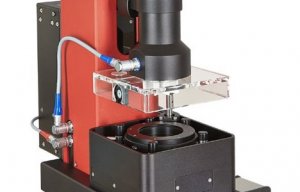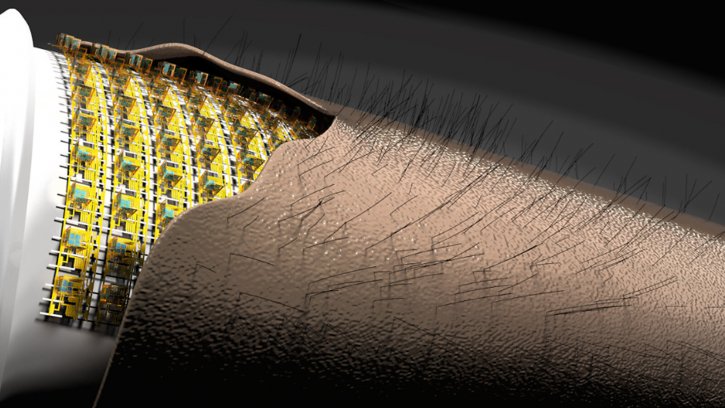
Haptic sensations at Techtextil North America 2021
Electronic skin anticipates and perceives touch from different directions for the first time.

12th May 2022
Innovation in Textiles
|
Chemnitz, Germany
A German research team has taken a major step forward in the development of sensitive electronic skin – e-skin – with integrated artificial hairs.
E-skins are flexible electronic systems that try to mimic the sensitivity of their natural human skin counterparts and applications for them range range from skin replacement and medical sensors on the body to artificial skin for humanoid robots and androids.
Tiny surface hairs can perceive and anticipate the slightest tactile sensation on human skin and even recognise the direction of touch. Modern electronic skin systems lack this capability and cannot gather critical information about their vicinity.
A research team led by Professor Oliver G. Schmidt at the Research Center for Materials, Architectures and Integration of Nanomembranes (MAIN), at Chemnitz University of Technology, has explored a new avenue to develop extremely sensitive and direction-dependent 3D magnetic field sensors that can be integrated into an active matrix e-skin system.
The team used a completely new approach for the miniaturisation and integration of 3D device arrays.
“Our approach allows a precise spatial arrangement of functional sensor elements in 3D that can be mass-produced in a parallel manufacturing process,” said Christian Becker, a PhD student at MAIN. “Such sensor systems are extremely difficult to generate by established microelectronic fabrication methods.”
Elegant origami
The core of the sensor system is a so-called anisotropic magnetoresistance (AMR) sensor which can be used to precisely determine changes in magnetic fields. AMR sensors are currently used, for example, as speed sensors in cars or to determine the position and angle of moving components in a variety of machines.

To develop the highly compact sensor system, the researchers took advantage of the so-called “micro-origami process”. This is used to fold AMR sensor components into three-dimensional architectures that can resolve the magnetic vector field in three dimensions. Micro-origami allows a large number of microelectronic components to fit into a small space and arrange them in a geometry that is not achievable by any conventional microfabrication technologies.
“Micro-origami processes were developed more than 20 years ago,and it is wonderful to see how the full potential of this elegant technology can now be exploited for novel microelectronic applications,” said Professor Schmidt.
The research team integrated the 3D micro-origami magnetic sensor array into a single active matrix, where each individual sensor can be conveniently addressed and read out by microelectronic circuitry.
Architecture
“The combination of active-matrix magnetic sensors with self-assembling micro-origami architectures is a completely new approach to miniaturise and integrate high-resolution 3D sensing systems,” said Dr Daniil Karnaushenko, who contributed decisively towards the concept, design and implementation of the project.
The research team has succeeded in integrating the 3D magnetic field sensors with magnetically rooted fine hairs into an artificial e-skin made of an elastomeric material into which the electronics and sensors are embedded – similar to organic skin, which is interlaced with nerves.
When the hair is touched and bends, the movement and exact position of the magnetic root can be detected by the underlying 3D magnetic sensors. The sensor matrix is therefore not only able to register the bare movement of the hair, but also determines the exact direction of the movement. As with real human skin, each hair on an e-skin becomes a full sensor unit that can perceive and detect changes in the vicinity. The magneto-mechanical coupling between 3D magnetic sensor and magnetic hair root in real-time provides a new type of touch-sensitive perception by an e-skin system. This capability is of great importance when humans and robots work closely together. The robot can, for instance, sense interactions with a human companion well in advance of an intended contact or an unintended collision.

Business intelligence for the fibre, textiles and apparel industries: technologies, innovations, markets, investments, trade policy, sourcing, strategy...
Find out more